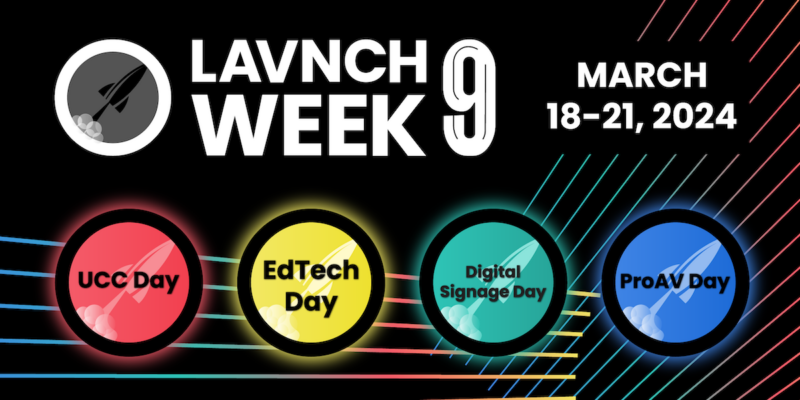InfoComm 2012: The Year of Conferencing
 Although we gave our Best of InfoComm 2012 Best New Technology Award to HDBaseT technology, if there was an omnipresent theme at this year’s show, it was Unified Communications (UC). To be perfectly honest, UC’s been around as an acronym for years – and it’s become one of those buzz-worthy terms that marketing and PR folks love trying to incorporate into all sorts of new product announcements to get the exposure for it – remember “multimedia” in the early 2000s?
Although we gave our Best of InfoComm 2012 Best New Technology Award to HDBaseT technology, if there was an omnipresent theme at this year’s show, it was Unified Communications (UC). To be perfectly honest, UC’s been around as an acronym for years – and it’s become one of those buzz-worthy terms that marketing and PR folks love trying to incorporate into all sorts of new product announcements to get the exposure for it – remember “multimedia” in the early 2000s?
Wikipedia defines Unified Communications as “the integration of real-time communication services such as instant messaging (chat), presence information, telephony (including IP telephony), video conferencing, data sharing (including web connected electronic whiteboards aka interactive whiteboards), call control and speech recognition with non-real-time communication services such as unified messaging (integrated voicemail, e-mail, SMS and fax). UC is not necessarily a single product, but a set of products that provides a consistent unified user interface and user experience across multiple devices and media types. There have been attempts at creating a single product solution; however, the most popular solution is dependent on multiple products.”
That’s a perfect definition of it and, yes, this is perfectly positioned to be dominated by the AV market.
And thanks to companies like Polycom, Microsoft, Juniper Networks and Logitech/LifeSize — the original founding members of the Unified Communications Interoperability Forum (UCIF) back in 2010 — UC is a standard that means that all UC-products will work and play together.
And, now we’re sitting on the cusp of an explosive few years of conferencing technology integration. Everything’s lining up:
1. Networking gear is getting cheap: The explosive growth of the networking hardware market and inexpensive access to cheap Megabit and soon Gigabit level routing and distribution will make for simple, UC product integration. You see, back when the videoconferencing market first debuts in AV some 15 years ago, it was not only iffy hardware performance, at best, but it was connected to a horribly unreliable network — both ISDN and T1 crap. Although the phone companies were providing us these huge data pipes, even they couldn’t keep them up and running reliably — and that was assuming they could even figure out how to install them. So, we, the AV’ers, were left to figure it all out and it was not only an expensive proposition, but most VTC installs seemed to never end — you’d receive calls over and over again from clients who couldn’t figure out why it wasn’t working. But now it’s all IP based — a system with rules and protocols that is, for the most part, amazingly reliable.
2. Wireless, wireless everywhere: The world’s going wireless. And, from what we can see so far, everything works well together. A MAC and a PC can be on the same network and exchange files flawlessly. You can even build networks with both Cisco and NetGear stuff and it’ll work just fine. And, with access points galore being put installed over the place, we’ll soon be in a world that’s always connected — heck, thanks to 3G and 4G technology, we’re already always connected — albeit not at the level of reliability we’d want for supporting VTC systems. But, soon we will. Thanks to technologies like WiMAX and 4G LTE, we’re well on our way to having fast, reliable wireless bandwidth that’ll support VTC stuff with no problems. And, who’s best positioned to put it in? AV’ers of course.
3. Killer hardware: Not only was this the largest turnout of UC manufacturers ever at an InfoComm, but the products they presented were also incredible. Obviously Polycom and Cisco had great shows and great products, but companies like Vidyo, Revolabs and BlueJeans should also be on your radar when picking UC tools to integrate over the coming months and years. In fact, we added a UC section to our InfoComm portal this year where we posted all the UC product videos we shot (over 90): https://www.ravepubs.com/index.php?option=com_ravevideo&view=single&Itemid=646
4. Microsoft Lync: Microsoft Lync is an enterprise-ready unified communications platform. With Lync, users can keep track of their contacts’ availability; send an IM; start or join an audio, video or web conference; or make a phone call—all through a familiar interface. Lync is built to fully integrate with Microsoft Office. The Microsoft Lync 2010 desktop client is available for Windows and for Mac and mobile versions are available for Windows Phone, iPhone/iPad, and Android devices. And, it’s all coming to AV thanks to the fact that a lot of companies are deciding to make their UC gear work and play well with MS Lync. Polycom certainly gets kudos from me being the first to join the Lync protocol, but I think everyone will, eventually. It will become the standard for all UC, all VTC, all audio conferences and, eventually, all phone telephony too (remember who owns Skype?).
So, what are you waiting for? This isn’t the early 2000s — this new round of VTC stuff is not only more reliable and better supported than ever before, but it’s way, way more profitable — because it just works. Whether you just have a client that just wants talking-head conferencing or a full Telepresence Collaboration Suite, it’s all waiting for the AV market to jump back in. But do it NOW — we don’t want the IT market to steal this out from under us. It’s a perfect opportunity to drive you into offering more IT-based products and solutions.
Gary Kayye is the founder of rAVe [Publications]. Reach him at gary@ravepubs.com





